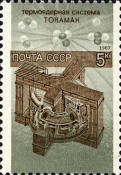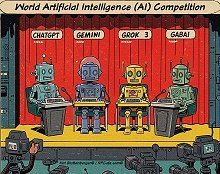Electronics & High Technology Components
- See Full List of AI Topics -
 A tokamak is a type of magnetic confinement device designed to harness the
power of nuclear fusion, the process that powers stars like the Sun. The tokamak
aims to confine plasma - an ionized gas at extremely high temperatures - using
magnetic fields, facilitating the fusion of hydrogen isotopes into helium. The
energy released from these fusion reactions holds the potential to provide
almost limitless, clean, and sustainable energy, without the drawbacks
associated with nuclear fission, such as long-lived radioactive waste. A tokamak is a type of magnetic confinement device designed to harness the
power of nuclear fusion, the process that powers stars like the Sun. The tokamak
aims to confine plasma - an ionized gas at extremely high temperatures - using
magnetic fields, facilitating the fusion of hydrogen isotopes into helium. The
energy released from these fusion reactions holds the potential to provide
almost limitless, clean, and sustainable energy, without the drawbacks
associated with nuclear fission, such as long-lived radioactive waste.
The concept of the tokamak was first developed in the Soviet Union in the
1950s, primarily by physicists Andrei Sakharov and Igor Tamm. The word "tokamak"
itself is derived from the Russian acronym for "toroidal chamber with magnetic
coils" (тороидальная камера с магнитными катушками). Sakharov and Tamm,
alongside their Soviet colleagues, sought a way to contain and control the
plasma, which reaches temperatures of tens of millions of degrees, far hotter
than the surface of the Sun. At these temperatures, no material container can
hold the plasma, so they turned to magnetic fields for confinement.
Early experiments in the Soviet Union showed promise, and by the 1960s, the
tokamak design was proving more effective than other competing fusion approaches
such as the stellarator, pinch devices, and magnetic mirrors. In 1968, the T-3
tokamak at the Kurchatov Institute in Moscow achieved remarkable results,
demonstrating significantly better plasma confinement than any other device at
the time. This marked a turning point for international interest in tokamaks,
with the Soviet results being verified by British scientists from the Culham
Centre for Fusion Energy in the United Kingdom. The success of T-3 led many
countries to abandon their existing fusion research programs in favor of the
tokamak design.
From the 1970s onward, tokamak research expanded across the globe. Major
research institutions and consortia, such as JET (Joint European Torus) in
Europe, Princeton Plasma Physics Laboratory (PPPL) in the United States, ITER
(International Thermonuclear Experimental Reactor), and various Japanese and
Chinese facilities, began investing heavily in tokamak development. ITER,
currently under construction in southern France, represents the largest and most
ambitious international collaboration in the history of fusion research,
involving China, the European Union, India, Japan, Russia, South Korea, and the
United States. ITER's goal is to demonstrate the feasibility of fusion power on
a commercial scale by achieving a plasma that can sustain a net energy gain,
where the energy produced by fusion exceeds the energy required to heat and
maintain the plasma.
Early tokamak designs, including the T-3, were relatively simple devices with
modest confinement capabilities. These designs used a combination of external
magnetic fields and plasma currents to confine the plasma in a donut-shaped, or
toroidal, geometry. However, as researchers began to push the limits of plasma
confinement and heating, they encountered a range of challenges. One of the key
issues was plasma instability. As the plasma becomes hotter and more energetic,
it tends to develop ripples and instabilities that can cause it to break away
from its magnetic confinement, leading to disruptions that can damage the
machine. This problem has been addressed over time through increasingly
sophisticated magnetic field configurations, such as magnetic field shaping, the
addition of divertors to remove impurities, and the use of external magnetic
coils to control instabilities.
Despite these improvements, achieving the conditions necessary for sustained
fusion—typically temperatures of 100 million degrees Celsius and sufficient
plasma density and confinement time—remains incredibly challenging. Many
tokamaks have achieved high temperatures, but maintaining the required
conditions for long periods (on the order of seconds or minutes) has proven
elusive. The JET tokamak, which became operational in the 1980s, achieved a
record for fusion power in 1997, producing 16 MW of power for a short period but
still consuming more energy than it generated. This lack of sustained net energy
production is one of the key hurdles that tokamak researchers are striving to
overcome.
More advanced designs like ITER aim to rectify this by building on the
successes of earlier devices. ITER's design incorporates much larger plasma
volumes, higher magnetic fields, and more advanced heating systems, including
neutral beam injection and radiofrequency heating. ITER is expected to achieve a
fusion power gain factor (Q) of at least 10, meaning it should produce ten times
more energy than is put into heating the plasma. However, despite significant
advances in understanding plasma physics, ITER's construction has been delayed
multiple times, and it is not expected to begin plasma operations until the
mid-2030s.
Alongside ITER, several smaller tokamaks around the world are also pushing
the boundaries of fusion research. These include the EAST tokamak in China,
which has achieved plasma confinement times on the order of 100 seconds, and the
K-STAR tokamak in South Korea, which has also made significant progress in
plasma stability and duration. There are also a number of private companies,
such as Tokamak Energy in the United Kingdom and Commonwealth Fusion Systems in
the United States, that are developing more compact tokamak designs, often using
novel technologies such as high-temperature superconductors to create stronger
magnetic fields.
The physics principles underlying the tokamak are rooted in magnetic
confinement fusion. At the core of the device's operation is the concept of a
toroidal magnetic field, which is generated by coils surrounding the
donut-shaped vacuum chamber. The plasma itself is electrically conductive, and a
current is induced within it, generating a poloidal magnetic field that,
combined with the toroidal field, creates helical field lines that wrap around
the plasma and confine it. This combination of magnetic fields forms a magnetic
bottle, holding the plasma in place and preventing it from contacting the walls
of the chamber. To achieve fusion, the plasma must be heated to extreme
temperatures, at which point the thermal motion of the ions overcomes their
electrostatic repulsion, allowing deuterium and tritium nuclei to collide and
fuse.
The advantages of tokamaks are clear: fusion, if achieved, would provide a
nearly inexhaustible energy source, fueled by isotopes like deuterium, which can
be extracted from seawater, and tritium, which can be bred from lithium. The
reaction itself produces no greenhouse gases and only minimal short-lived
radioactive waste. Fusion also carries no risk of catastrophic meltdowns, as the
reaction is inherently self-limiting; if any aspect of the process fails, the
plasma rapidly cools, halting fusion.
However, there are significant disadvantages and risks associated with
tokamaks. The technology remains complex and expensive, with the construction of
devices like ITER costing tens of billions of dollars. The materials used in the
reactor must withstand extreme conditions, including high temperatures, intense
neutron bombardment, and the stresses of powerful magnetic fields, leading to
challenges in material science. Plasma instabilities and disruptions continue to
pose risks to the operation of tokamaks, potentially damaging components or
reducing efficiency. Additionally, while fusion reactions themselves are clean,
the production and handling of tritium - a radioactive isotope of hydrogen -
pose environmental and safety concerns, though these risks are generally
considered more manageable than those associated with fission reactors.
The tokamak represents one of the most promising avenues for achieving
controlled nuclear fusion and unlocking an almost limitless supply of clean
energy. From its origins in the Soviet Union to its current status as the focus
of international research collaborations like ITER, the tokamak has been at the
forefront of fusion science for decades. While significant technical challenges
remain, particularly in achieving sustained net energy production, advances in
plasma physics, materials science, and magnetic confinement technology continue
to bring the dream of fusion power closer to reality. The coming decades will be
critical in determining whether tokamaks can fulfill their promise and
revolutionize the global energy landscape.
 This content was generated by primarily
with the assistance of ChatGPT (OpenAI), and/or
Gemini (Google), and/or
Arya (GabAI), and/or Grok
(x.AI), and/or DeepSeek artificial intelligence
(AI) engines. Review was performed to help detect and correct any inaccuracies; however,
you are encouraged to verify the information yourself if it will be used for critical
applications. In all cases, multiple solicitations to the AI engine(s) was(were)
used to assimilate final content. Images and external hyperlinks have also been
added occasionally - especially on extensive treatises. Courts have ruled that AI-generated
content is not subject to copyright restrictions, but since I modify them, everything
here is protected by RF Cafe copyright. Many of the images are likewise generated
and modified. Your use of this data implies an agreement to hold totally harmless
Kirt Blattenberger, RF Cafe, and any and all of its assigns. Thank you. Here is
Gab AI in an iFrame. This content was generated by primarily
with the assistance of ChatGPT (OpenAI), and/or
Gemini (Google), and/or
Arya (GabAI), and/or Grok
(x.AI), and/or DeepSeek artificial intelligence
(AI) engines. Review was performed to help detect and correct any inaccuracies; however,
you are encouraged to verify the information yourself if it will be used for critical
applications. In all cases, multiple solicitations to the AI engine(s) was(were)
used to assimilate final content. Images and external hyperlinks have also been
added occasionally - especially on extensive treatises. Courts have ruled that AI-generated
content is not subject to copyright restrictions, but since I modify them, everything
here is protected by RF Cafe copyright. Many of the images are likewise generated
and modified. Your use of this data implies an agreement to hold totally harmless
Kirt Blattenberger, RF Cafe, and any and all of its assigns. Thank you. Here is
Gab AI in an iFrame.
AI Technical Trustability Update
While working on an update to my
RF Cafe Espresso Engineering Workbook project to add a couple calculators about
FM sidebands (available soon). The good news is that AI provided excellent VBA code
to generate a set of Bessel function
plots. The bad news is when I asked for a
table
showing at which modulation indices sidebands 0 (carrier) through 5 vanish,
none of the agents got it right. Some were really bad. The AI agents typically explain
their reason and method correctly, then go on to produces bad results. Even after
pointing out errors, subsequent results are still wrong. I do a lot of AI work
and see this often, even with subscribing to professional versions. I ultimately
generated the table myself. There is going to be a lot of inaccurate information
out there based on unverified AI queries, so beware.
Electronics & High Tech
Companies | Electronics &
Tech Publications | Electronics &
Tech Pioneers | Electronics &
Tech Principles |
Tech Standards Groups &
Industry Associations | Societal
Influences on Technology
|








